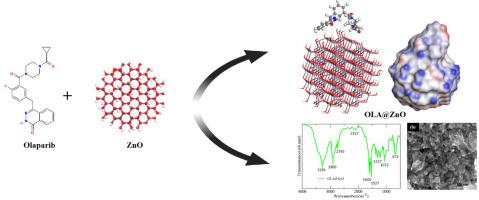预测奥拉帕尼在氧化锌纳米颗粒上的吸附行为以改善ph响应性药物递送:实验和DFT见解。
IF 4.7
3区 医学
Q1 PHARMACOLOGY & PHARMACY
引用次数: 0
摘要
奥拉帕尼(OLA)等疏水抗癌药物的高效给药系统的开发仍然是癌症治疗的关键挑战。本研究通过综合实验和计算方法,对负载ola的氧化锌纳米颗粒(OLA@ZnO)进行了全面的研究,以优化ph响应性给药。采用溶胶-凝胶法合成了ZnO纳米颗粒,并利用SEM、XRD、FTIR和UV-Vis光谱对其进行了表征,发现Zn 2 +通过羰基配位和π-堆叠相互作用成功加载了OLA。纳米复合材料具有优异的胶体稳定性(zeta电位 = 在pH 7.4时为11 mV)和pH触发的药物释放,20 h(生理pH)释放率为100%,24 h(酸性pH)释放率为90%。Korsmeyer-Peppas模型证实了中性pH下的扩散主导释放(n = 0.52)和酸性条件下的侵蚀控制释放(n = 0.69)。密度泛函理论(DFT)计算表明,HOMO-LUMO间隙缩小(4.89 → 3.21 eV),偶极矩增大(5.7 → 9.13 D),显示出强电荷转移。分子描述符强调了增强的反应性(柔软度 = 0.621 eV⁻¹)和pH敏感性(亲电性 = 4.54 eV),而降低的密度梯度(RDG)分析显示了关键的结合作用(Zn²+ c =O配位的-0.9 eV)。热力学分析表明自发吸附(ΔG = -0.77至-0.89 eV),放热行为(ΔH = -0.87至-1.00 eV)和熵驱动释放(ΔS = -0.00034至-0.00037 eV/K)。尺寸依赖性趋势表明,较小的纳米颗粒(0.9 nm)可用于急性治疗的快速释放(τ = 1.05 s),而较大的纳米颗粒(2.0 nm)可用于慢性治疗的持续释放(τ = 152 s)。这些发现为设计可调zno基纳米载体建立了坚实的结构-性能关系,为提高OLA和其他疏水药物在靶向癌症治疗中的治疗效果提供了一个有希望的策略。本文章由计算机程序翻译,如有差异,请以英文原文为准。

Predicting the adsorption behavior of olaparib on zinc oxide nanoparticles for improved pH-responsive drug delivery: experimental and DFT insights
The development of efficient drug delivery systems for hydrophobic anticancer drugs like Olaparib (OLA) remains a critical challenge in cancer therapy. This study presents a comprehensive investigation of OLA-loaded zinc oxide nanoparticles (OLA@ZnO) through integrated experimental and computational approaches to optimize pH-responsive drug delivery. ZnO nanoparticles were synthesized via a sol-gel method and characterized using SEM, XRD, FTIR, and UV–Vis spectroscopy, revealing successful OLA loading through Zn²⁺-carbonyl coordination and π-stacking interactions. The nanocomposites exhibited excellent colloidal stability (zeta potential = 11 mV at pH 7.4) and pH-triggered drug release, with 100 % release in 20 h (physiological pH) versus 90 % in 24 h (acidic pH). Korsmeyer-Peppas modeling confirmed diffusion-dominated release (n = 0.52) at neutral pH and erosion-controlled release (n = 0.69) in acidic conditions. Density functional theory (DFT) calculations revealed strong charge transfer, evidenced by a narrowed HOMO-LUMO gap (4.89 → 3.21 eV) and increased dipole moment (5.7 → 9.13 D). Molecular descriptors highlighted enhanced reactivity (softness = 0.621 eV⁻¹) and pH sensitivity (electrophilicity = 4.54 eV), while reduced density gradient (RDG) analysis visualized key binding interactions (−0.9 eV for Zn²⁺-C = O coordination). Thermodynamic analysis demonstrated spontaneous adsorption (ΔG = −0.77 to −0.89 eV) with exothermic behavior (ΔH = −0.87 to −1.00 eV) and entropy-driven release (ΔS = −0.00034 to −0.00037 eV/K). Size-dependent trends showed that smaller nanoparticles (0.9 nm) enabled rapid release (τ = 1.05 s) for acute therapy, while larger nanoparticles (2.0 nm) provided sustained delivery (τ = 152 s) for chronic treatment. These findings establish a robust structure-property relationship for designing tunable ZnO-based nanocarriers, offering a promising strategy to improve the therapeutic efficacy of OLA and other hydrophobic drugs in targeted cancer therapy.
求助全文
通过发布文献求助,成功后即可免费获取论文全文。
去求助
来源期刊
CiteScore
9.60
自引率
2.20%
发文量
248
审稿时长
50 days
期刊介绍:
The journal publishes research articles, review articles and scientific commentaries on all aspects of the pharmaceutical sciences with emphasis on conceptual novelty and scientific quality. The Editors welcome articles in this multidisciplinary field, with a focus on topics relevant for drug discovery and development.
More specifically, the Journal publishes reports on medicinal chemistry, pharmacology, drug absorption and metabolism, pharmacokinetics and pharmacodynamics, pharmaceutical and biomedical analysis, drug delivery (including gene delivery), drug targeting, pharmaceutical technology, pharmaceutical biotechnology and clinical drug evaluation. The journal will typically not give priority to manuscripts focusing primarily on organic synthesis, natural products, adaptation of analytical approaches, or discussions pertaining to drug policy making.
Scientific commentaries and review articles are generally by invitation only or by consent of the Editors. Proceedings of scientific meetings may be published as special issues or supplements to the Journal.

 求助内容:
求助内容: 应助结果提醒方式:
应助结果提醒方式:


